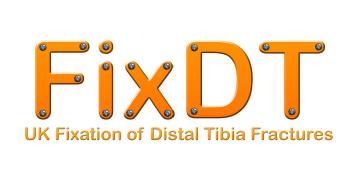FIXDT: UK Fixation of Distal Tibia Fractures

UK Fixation of Distal Tibia Fractures Trial is a randomised controlled trial comparing intramedullary nail fixation with locking plate fixation for patients with a distal tibia fracture.
Background:
The treatment of fractures of the lower third of the tibia remains controversial. These injuries are difficult to manage because the blood supply to the skin over the bone is poor and because the proximity of the fracture to the ankle joint. Infections and problems of bone healing are well recognised complications.
Most of these injuries require surgery. The most common methods of fixation are: intramedullary nail fixation and locking plate fixation. At present, there is limited evidence as to which technique is better with regards to healing of the bone, ankle function and quality of life.
Study Design:
Multi-centre randomised controlled trial where participants will be randomised on a 1:1 basis, stratified by trial centre and participant age. The target recruitment is 320 patients and patients will be followed up at 6 weeks, 3 months, 6 months and 12 months post operatively.
Primary outcome:
The primary objective is to quantify and draw inferences on observed differences in the patient reported functional outcome measure the Disability Rating Index between the trial treatment groups in the first year post-injury.
Secondary outcomes:
The secondary research objective for this trial is to draw inferences on the observed differences in the functional outcome measure Olerud and Molander (OMAS) score and the quality of life score (EQ-5D) and radiological outcomes (mal-union, mal-alignment and shortening), cost-effectiveness and complication rates between the two treatments.
Inclusion criteria:
•Aged 16 years or over and able to give informed consent
•Any fracture which involves the distal tibia metaphysis – defined as a fracture extending within 2 Muller squares of the ankle joint
•In the opinion of the attending surgeon, the patient would benefit from internal fixation of the fracture
Exclusion criteria:
•In the opinion of the attending surgeon, there is a contraindication to intra-medullary nailing
•The fracture is open
•There is a contra-indication to anaesthesia
•There is evidence that the patient would be unable to adhere to trial procedures or complete postal questionnaires
•The fracture extends into the ankle joint (i.e intra-articular)
Registrations
- ISRCTN99771224
- Ethical Approval 12/WM/0340
Funder
- NIHR HTA programme
11/136/04
Sponsors
- University of Warwick
- University Hospitals Coventry and Warwickshire NHS Trust
Schedule
- Start date 01/03/2013
End date 28/02/2017
Chief Investigator
- Professor Matthew Costa
IContacts
-
cturesources at warwick dot ac dot uk
Key People
- Professor Matthew Costa - Professor of Trauma and Orthopaedic Surgery
- Dr Juul Achten - Senior Research Fellow
- Professor Stavros Petrou - Health Economist
